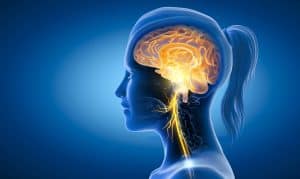Have you ever noticed the immediate sense of relief you get after taking one deep breath? Do you wonder why you feel so amazing after a good, long laugh with a friend? Does rubbing the skin around your ears relax you, but you aren’t sure why? All of these actions stimulate your vagus nerve, one of the major cranial nerves that controls many of the major systems in your body. Read on to learn more about how to stimulate the vagus nerve through deep breathing, meditation, and even laughing.
What Is the Vagus Nerve?
Your vagus nerve is one of twelve cranial nerves in your body, each of which come in pairs. Although we’ll talk about the nerve as a singular entity, it’s actually made up of two nerves that come out of each side of your brain stem at the lowest point. If you place your fingers at the very base of your skull, on either side of the small notch at the top center of your neck, you’ll be pretty close to where your nerves emerge.
Vagus nerves handle a number of bodily functions, including regulating our bodies’ heart rates and breathing, managing digestion, and controlling your reflexes. Our vagal nerves control when you swallow, cough, sneeze, and even gag. It also controls cardiovascular activity other than your heart rate and can play a big role in heart health.
What Are the Symptoms of a Bad Vagus Nerve?
When your vagus nerve function isn’t working the way it should, it can lead to a variety of issues that affect your digestion, heart rate, and even your voice. Some common symptoms of a bad vagus nerve include
- Abdominal pain and bloating
- Acid reflux (gastroesophageal reflux disease, GERD)
- Changes to your heart rate, blood pressure, or struggles with blood sugar
- Difficulty swallowing, losing control of a gag reflex
- Dizziness, lightheadedness, or fainting
- Hoarseness, wheezing or losing your voice
- Feeling depressed and anxious
You can restore your balance and well-being by paying more attention to your vagus nerve and giving it some love and support through exercises and lifestyle changes.
Somatic vs. Visceral Components
Some of your other cranial nerves control sensory information, such as sights, sounds, tastes, smells, and sensations. Others handle muscle function and operation of different glands in your body. This nerve is one of those pairs that handles both functions, which is why stimulation can be so powerful.
Vagus nerves can also have somatic components, which impact sensations you feel on your skin or in your muscles. They can also have a visceral component, which impacts sensations you feel in your organs. Either of these components can play a role in either sensory functions or motor functions throughout your body.

Vagus Nerve Function
This nerve performs several sensory functions, meaning it provides you with sensation in different areas of the body. It provides somatic sensory information for parts of your ear and throat. If you run your finger along the skin behind your ear, the sensation you feel is running along your nerve.
The vagus nerve function also provides visceral sensory information that comes from deeper in your body. This nerve controls sensation in your esophagus, trachea, larynx, lungs, heart, and digestive tract. Any time you have a stomach ache or a sore throat, you can thank your nerve for carrying those signals to your brain.
Motor Functions
Your vagus nerve also controls several motor functions throughout your body. Your nerves carry the signals from your brain out to the muscle or organ that’s doing the work and then back to your brain. This nerve controls motor function in your larynx, throat, and soft palate, which is why it plays a role in your gag reflex.
The nerve stimulates muscles in your heart in order to regulate your resting heart rate, or your heart rate when you’re not doing anything strenuous. It also controls the contractions that happen in your gut as a normal part of your digestive process. These contractions happen along your esophagus, stomach, and most of your intestines to move food along this tract.
What Is Vagus Nerve Stimulation?
Now that we know a little more about the vagus nerve, let’s talk some about nerve stimulation. As you might guess from the name, nerve stimulation involves causing activity along your nerve. Although this can be as simple as running your finger over the skin behind your ear, it can also involve more complicated procedures.
Often, when people refer to vagus nerve stimulation, they’re referencing a procedure that uses electrical impulses to stimulate your vagus nerve. Doctors sometimes use this type of nerve stimulation to treat epilepsy or depression. Some experts also believe this procedure could help with multiple sclerosis, Alzheimer’s disease, cluster headaches, and more.
Vagal Toning Exercises
Adding more vagal toning exercises into your daily routine can help improve its nerve function and promote relaxation, better digestion, and foster your well-being.
1) Vagus Nerve Stimulation Devices
The medical procedure known as vagus nerve stimulation uses a device to deliver carefully controlled electrical impulses. This device gets implanted under the skin of your chest and is about the size of a military ID tag. It has a wire that runs up to the vagus nerve on the left side of your brain stem and sends electrical signals through the nerve and into your brain.
Most of the time, neurologists program stimulation devices to send signals at appropriate intervals. However, sometimes, patients may be given a magnet that can control the device, too. This can be helpful in the case of depression or cluster headaches, when the patient can tell that their symptoms are getting worse.
2) Vagus Nerve Deep Breathing
Although vagus nerve stimulation devices are the most well-researched method of vagus nerve stimulation, they’re not the only way to do it. Because it is connected to so many parts of your body, you can perform vagus nerve exercises in a number of ways yourself. Working on vagus nerve deep breathing can help to bring you back into balance and may ease some of your symptoms.
Deep breathing and vagus nerve meditation are two of the most effective ways to stimulate your nerve. Remember, this nerve controls movement in your lungs, your heart, and your mouth and throat. Practicing breathing exercises and meditating can send positive signals up that nerve and work on vagus nerve toning to strengthen the pathway there.
Does Humming Stimulate the Vagus Nerve?
Given how connected your vagus nerve is to your throat, it also makes sense that humming and chanting would stimulate the vagus nerve. For one thing, the vibrations caused by singing, humming, or chanting will resonate up the vagus nerve. But chanting a mantra that naturally resonates with the positive energy of the universe can bring even more positivity and light into your being.
Chanting the sacred “om” is always a good bet when you’re trying to stimulate your vagus nerve and you don’t know where to start. You can also say one of the sutras or a favorite prayer from your religion. You may also want to chant a personal mantra that empowers you and promotes healing for your body, mind, and spirit.
Laughter to Stimulate Your Vagus Nerve
Another fabulous way to stimulate your vagus nerve is through laughter. Studies have shown that laughter is good for your health for a number of different reasons. It stimulates your heart, improves your intake of oxygen, stimulates your lungs and muscles, and amps up your endorphin production.
If you’re feeling like you need some vagus nerve stimulation, try to make plans with friends or loved ones who always make you laugh, even if those plans happen over virtual platforms. Watch a favorite movie or listen to a comedian you like. You could even play with your pets or your kids, read a book that makes you giggle, or scroll through comedy accounts on social media.

Learn More About Vagal Toning
The nerve touches many of the vital areas of your body, including your heart, lungs, digestive tract, and more. Vagus nerve stimulation can help to ease symptoms of depression, epilepsy, indigestion, and more. You can practice vagus nerve stimulation at home through deep breathing, chanting, and laughter, among other methods.
If you’d like to learn more about methods of self-healing beyond toning the vagus nerve, check out the rest of my site at PaulWagner.com. I am here to help you awaken and bravely create an inspired life. Learn more about my services today and start changing your life in the most positive way.
REMEMBER!
You are a beautiful Living Being filled with light and love, born from stardust. You are unlimited potential in every direction. With a focus on discipline, virtue, and your own goodness, you can become as expanded and liberated as you desire.





